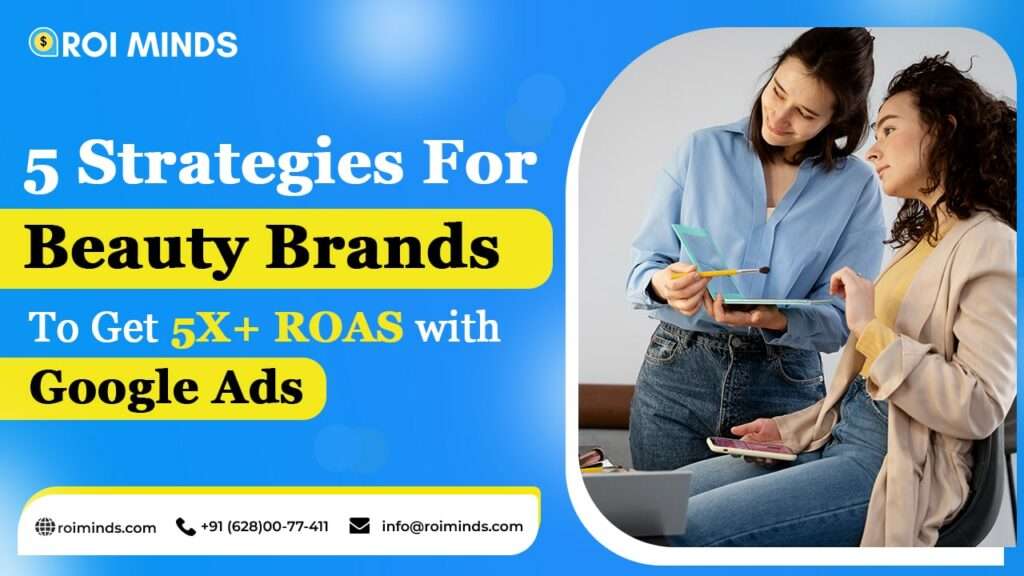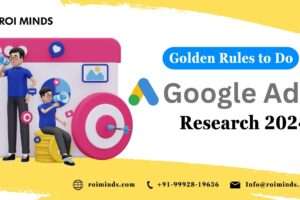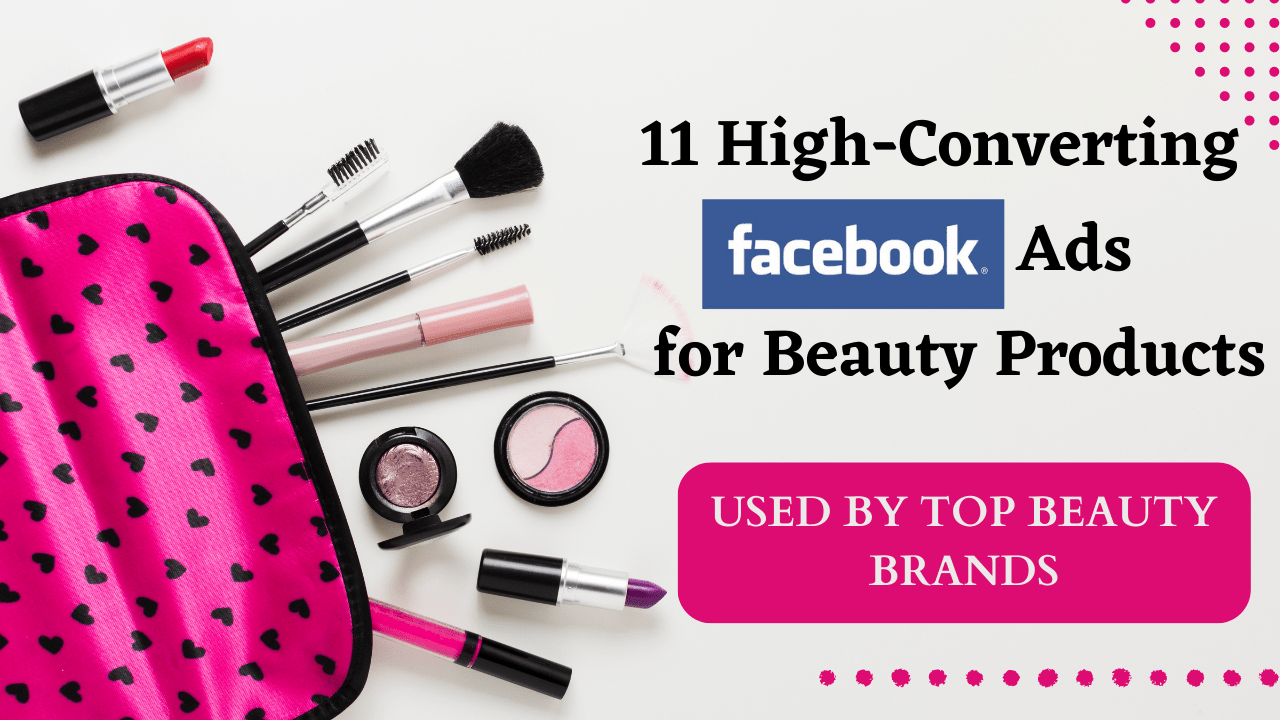Are you running Google ads for your beauty brand? If yes, you must know the importance of a profitable Return On Ad Spend (ROAS). In this blog post, we have highlighted the top Google ads strategies that have delivered more than 5x ROAS for our clients.
Let’s explore these PPC strategies for beauty brands in detail to run successful Google ads:
1. Segmentation: Asset Groups by Audience
Ad assets are the creatives, ad copies, and landing pages you want to test with different audiences to achieve the desired results. Targeting the right ad assets to the right audience delivers the maximum returns.
Segmentation is similar to creating important sections for different groups of audiences. Segmenting the high-performing creative assets and hero products enables the proper utilization of the ad budget. We have witnessed 80% of results come from 20% ad spending, so segmentation helps the ROAS be profitable.
Segmentation is also a way to categorize your audience based on their interests, behaviors, and buying journeys. It can tap specific characteristics like age, interests, ideas, values, etc.
Beauty brands running Google Shopping ads can segment their campaigns on labels, categories, product types, high-sellers, specific audiences, etc.
Beauty brands running Pmax campaigns can segment their assets to different audiences as Pmax allows the usage of various audiences through its targeting settings.
Understand some of the Cold segments below:
1. Interest Targeting
Connect with users based on their passions, hobbies, and browsing habits. You can select this audience to reach people interested in relevant beauty products, brands, or websites. This audience reaches a pertinent audience on Google properties like Gmail, Google Discover, YouTube, Google Display, etc.
Interest targeting is the best method for planning a campaign. Going beyond product selling and discussing consumer concerns, like Glass skin and anti-aging solutions, can target all beauty enthusiasts. For an impactful campaign, you can follow the beauty trends.
2. Demographic
Reach users based on life stages, like income or family situation. Customizing messages according to the age groups of your target audience will help you understand customer psychology and buying behavior. On the other hand, factors like income will help a brand understand the customer’s purchasing decision.
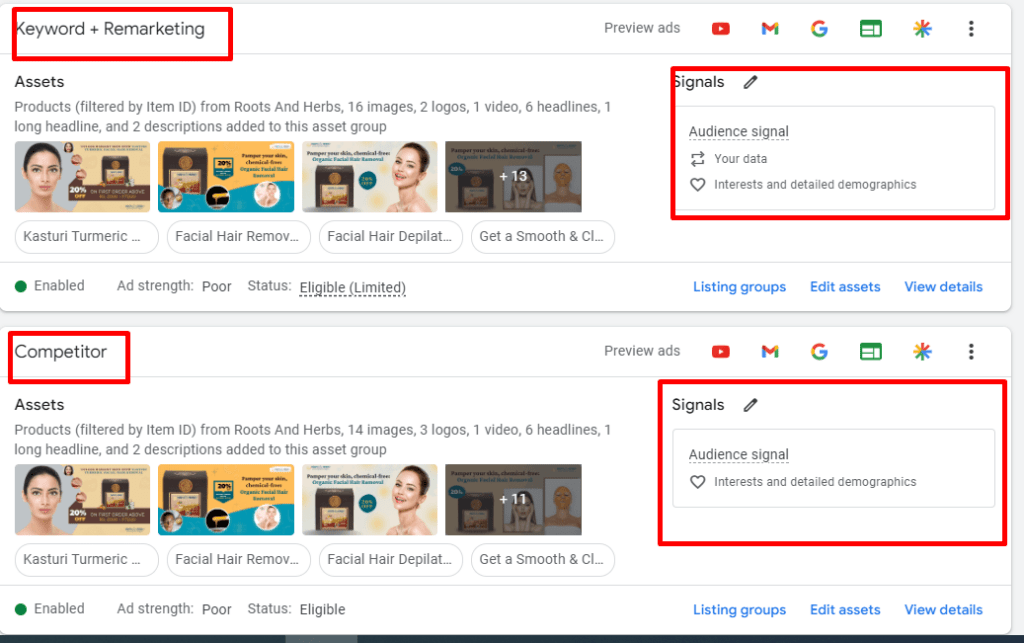
3. Purchase Intent
Target users considering products similar to your product can be a high-quality lead for you. You can benefit from purchase intent targeting by connecting with users through an SEO strategy while retargeting window shoppers.
4. Past Interactions
Reconnect with users who have already interacted with your brand. Check the following for the same:
-
Website/App Visitors
Contact people who have browsed your website or used your app.
-
Customer List
Connect with existing customers based on your customer relationship management (CRM) data.
-
Lookalike Audiences
Discover new users with similar interests to your existing customers.
Segmentation is effective when it goes beyond targeting the right audience with the right message. It is a key to gaining valuable insight into your competitors’ strategies. By smartly analyzing different aspects, you can get information about target demographics. All this can help you with SWOT analysis and ultimately refine your campaigns for a competitive edge.
This ongoing process requires regular monitoring and flexibility to adapt new strategies. Continuous optimization ensures you reach the right audience with the most compelling message, maximizing your return on investment.
2. Utilize Ad Extensions to Showcase Product Features:
You can enhance PPC for beauty brands using ad extensions. These are like tiny text bubbles that pop up next to your advert. They let you showcase more about your products or services. It highlights vital pointers and unique features. Eventually, it helps grab attention and urge people to click on your ad.
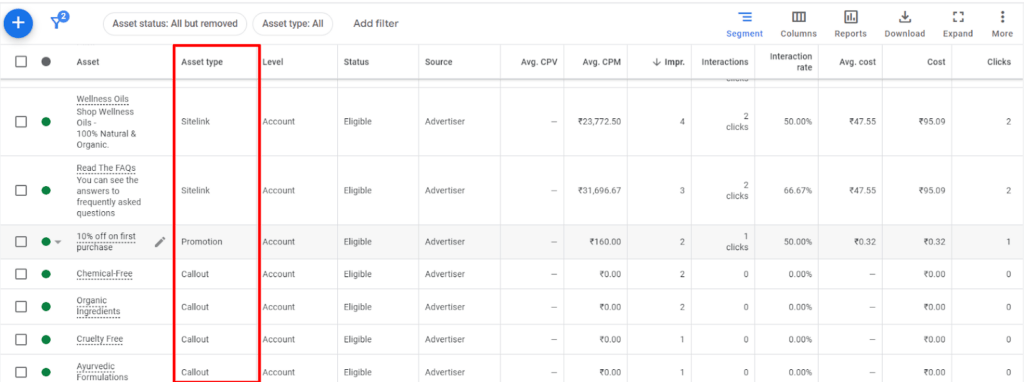
Follow the tips given below:
- Craft short, impactful callouts focusing on crucial selling points.
- Highlight unique selling propositions (USPs). These can be free shipping, 24/7 support, etc. It will make your business stand out.
- Keep things fresh! Rotate callouts regularly to avoid ad fatigue and stay relevant. (Think seasonal promotions!)
- Align callouts with your ad content and keywords for a smooth, relevant experience (boosts quality score!).
- Monitor callout performance regularly. Identify high-performing callout extensions and optimize the ones that need a boost.
3. Implement Dynamic Remarketing for Product Recommendations:
Remarketing allows you to show ads to buyers who have previously visited your website or used your mobile app. Dynamic remarketing takes it further by allowing you to market previous visitors’ ads that contain products and services they viewed on your site.
It also allows you to craft messages according to the audience. In return, this helps build leads and sales by bringing previous visitors back to your site to complete their actions, such as purchasing a product added to an online shopping cart.
Steps to set up the dynamic remarketing campaign:
- Create a new campaign.
- Define your campaign objective like sales, awareness/engagement.
- Choose your campaign type.
- Set up your campaign settings like budget, location, & Bidding Strategy.
- Set up your Product Feed in the Product listing Group.
- Add audience signals for the remarketing audience.
- Choose your desired audience to whom you want to serve ads again under the YOUR DATA option. Here, you can target your audience, which has previously visited your site. Audiences like All website visitors, All convertors, Add to cart, Initial checkout, etc.
- If you still need to create an audience, you can make your custom audience under the Audience Manager.
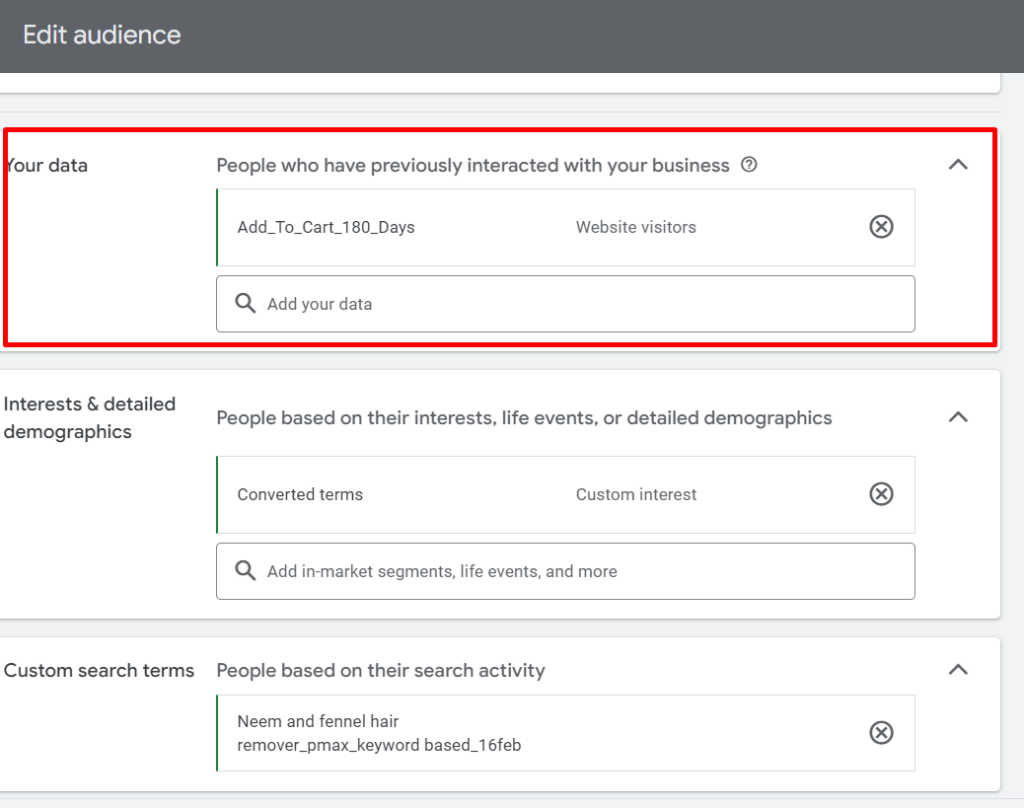
What a typical dynamic remarketing audience might include:
- Data Source: This section will specify the data source used to create the remarketing audience. In most cases, it will be “Website visitors”. This means the audience is built based on users who have previously interacted with your website.
- Conditions: This section defines the criteria for users to be included in the audience. It might include:
- All page views: This includes anyone who visited any page on your website.
- Visited specific pages: This target is users who visit particular product pages, browse categories, or view other relevant content. For a beauty brand, this could be users who browse lipstick product pages.
- Time since last visit: This allows you to target users who visited your website within a specific timeframe, like the previous 30 days.
- Audience Size: This section shows the estimated number of users who meet the defined criteria and are included in the remarketing audience.
4. Target High-Intent Keywords and Long-Tail Queries:
When creating Google Ads for beauty brand campaigns, targeting keywords people are likely to use when they’re ready to buy something is essential. These are called high-intent keywords and long-tail queries.
High-intent keywords are words or phrases that show someone is close to making a purchase. Long-tail queries are more specific search phrases that are typically longer than three words. They are usually less competitive than broad keywords. Choosing long-tail keywords is one of the best decisions when doing Google ads keyword research.
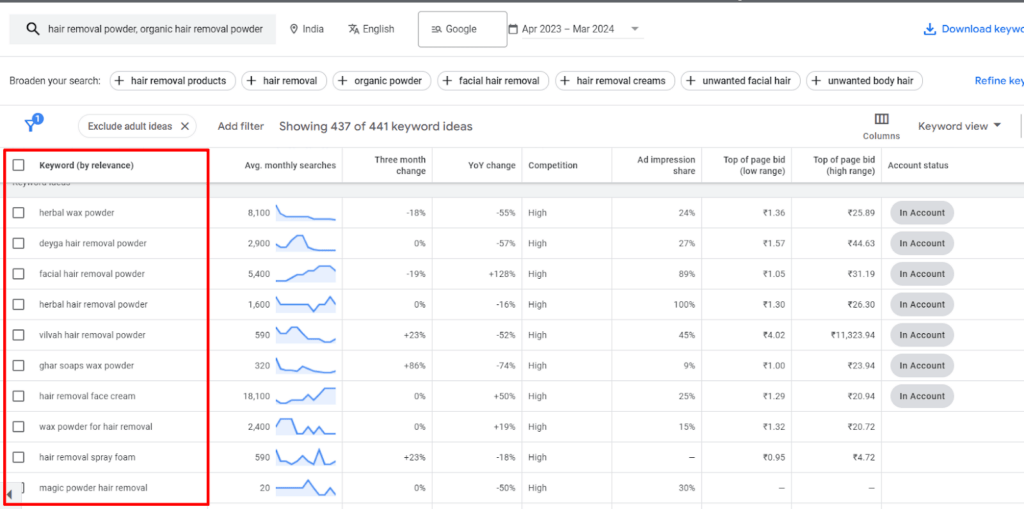
How to select appropriate keywords and queries:
- Brainstorm product & service terms (organic makeup, vegan skincare)
- Use Keyword Planner’s “Discover new keywords” tool with seed terms
- Filter by phrase/exact match, location & device (mobile/desktop)
- Find long-tail gems within filtered results (cruelty-free mascara for brown eyes)
- Explore “Long Tail Keyword Ideas” for hidden opportunities
- Analyse search volume & competition – find the sweet spot!
- Research competitor keywords for inspiration
- Organise keywords by product, intent (info vs buy), and campaign goals
5. Optimize Landing Pages for Maximum Conversion:
The landing pages play an essential role in converting clicks into customers. When someone clicks on your ad, they expect to see a website page relevant to what they searched for and saw in your advert. They will leave the website quickly if they are still looking for what they want to see.
Here are a few tips to create and optimise your landing pages:
- Ads & keywords should reflect your landing page. For example: “Salicylic Acid” is a keyword. Your landing page must reflect this keyword by displaying that particular product.
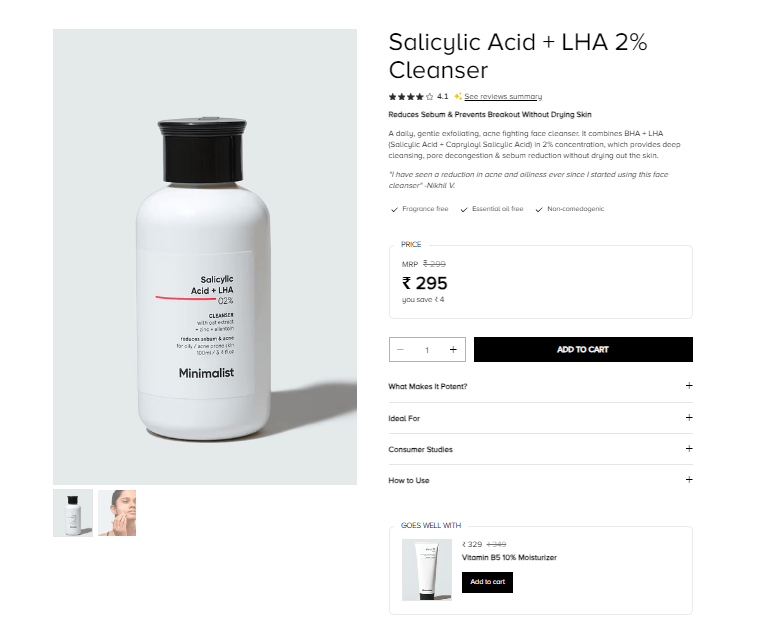
- Many people visit your site on their phones. Make your landing page mobile-friendly and easy to navigate!
- Let users complete desired actions (buy, call, inquire) with easy-to-locate buttons.
- To make your landing page more relevant, include critical details like reviews and ingredient details of your product.
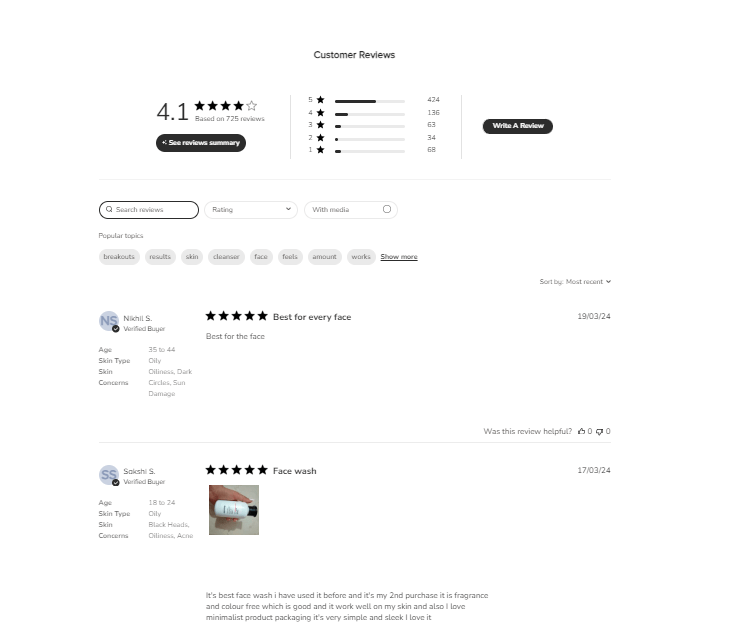
Bonus Points:
There is more to getting 5X+ ROAS with Google ads for beauty brands. Here are the bonuses for you!
1. Build a Robust Bid Strategy in Google Ads
Choosing the right bid strategy in Google Ads directly impacts the profitability of your beauty brand’s campaign. These are some key factors to consider when selling your beauty products.
A. Campaign Goals:
- Maximize Return on Ad Spend (ROAS): Use Target ROAS to optimize for a specific return on your ad spend. Set your desired ROAS, and Google Ads will automatically adjust bids to meet your budget target. This strategy is ideal if maximizing return is your top priority.
- Maximize Conversion Value: To generate the highest total sales revenue, consider Maximize Conversion Value. This strategy prioritizes conversions with higher values within your budget.
B. Level of Control:
- Automated Bidding: Target ROAS and Maximize Conversion Value are automated bid strategies. Google Ads leverages machine learning to optimize bids based on your goals and historical data. This frees up your time but requires trust in the algorithm’s decisions.
- Semi-Automated Bidding: Enhanced CPC (ECPC) balances control and automation. You set base bids, and Google Ads can increase or decrease them based on the likelihood of a conversion. This approach allows you to influence bid adjustments while benefiting from Google’s machine-learning capabilities.
- Manual Bidding: For experienced users seeking maximum control, Manual Bidding allows you to set bids for each product or product group. This approach requires close monitoring and adjustments based on performance data, making it a time-intensive strategy.
2. Develop a Solid Google Shopping Campaign For Product Feed Optimization
You’ve nailed the foundation of successful Google Shopping campaigns! An optimized product feed is essential for getting your beauty products seen by the right audience and driving those conversions. Let’s break down why each element you mentioned is so crucial:
-
High-quality product images:
Captivating product images is vital in the visual world of online shopping. They should be professionally clear and showcase your products from multiple angles. Consider including close-up shots to highlight details and textures.
-
Compelling titles:
Clear, concise titles that accurately describe your products and include relevant keywords are critical. Consider including your brand name, product line, shade or color, and key features to give users a quick understanding of what you’re offering.
-
Detailed descriptions:
Go beyond basic info. Provide rich descriptions highlighting your products’ benefits and addressing potential user concerns. Remember to weave in relevant keywords naturally throughout the text.
-
Accurate product attributes:
Utilize all relevant product attributes, such as color, size, brand, and material. This ensures your products appear in searches where users actively seek those specific features.
-
Promotions and sales:
Showcase any promotions or sales within the product feed to grab user attention and entice them to click on your ad.
-
Regular feed updates:
Remember to set it and remember it! Maintain an updated product feed to reflect any changes in stock, pricing, or promotions. This ensures users are seeing the most accurate information about your offerings.
With these tips, you can significantly improve the performance of your Google Shopping campaign and achieve a profitable return on ad spend.
Case Studies of Our Successful Beauty Google Ads (PPC) Campaigns at ROI Minds
ROI Minds, the best beauty PPC company, ran a PPC campaign for an Indian beauty and cosmetics store. Within a month, they achieved a staggering ROAS (Return On Ad Spend) of 6.47. This translates to impressive marketing efforts that generated significant results. This is a case study to make you understand ROI Minds campaigns that witness success.
1. Generated 6X+ ROAS with Google Ads for an Indian Beauty & Cosmetics Store in Just 1 Month
- We have achieved an impressive ROAS of 6.47. It highlights the effectiveness of our marketing efforts.
- We secured 770.29 conversions. It showcases efficient budget allocation and cost savings by us.
- Maintained an ad spend of ₹117K. Implementing cost-effective marketing while maximizing ROI.
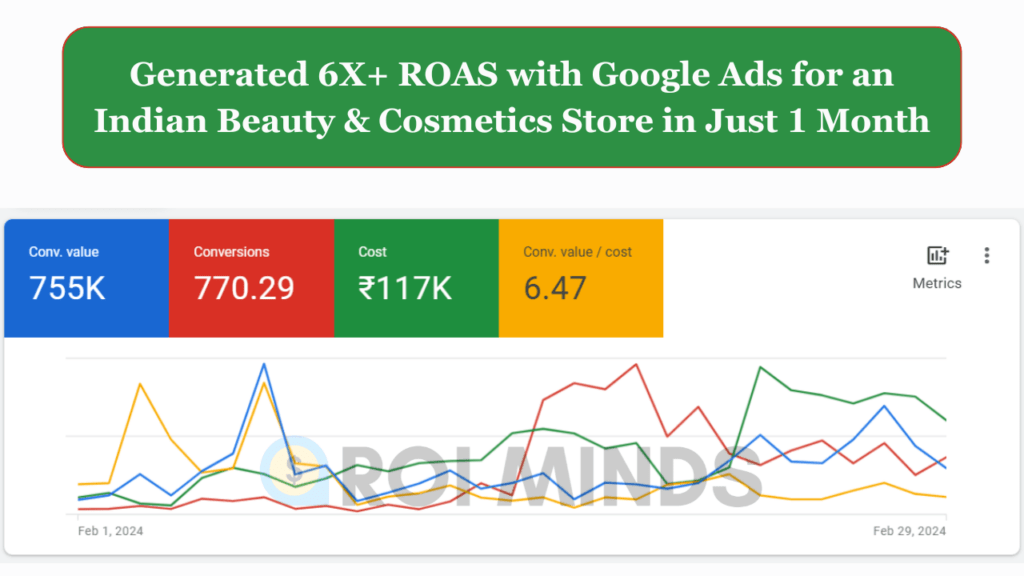
2. Achieved 6X+ ROAS for a US-Based Beauty Products Online Store with PPC in 1 Month
- We implemented cost-effectiveness, maintaining a cost spend of $122K.
- We got around 6.5K conversions. It shows our effective budget allocation and management.
- Our team achieved an ROAS of 6.24. This shows the skills and expertise that our professionals have.
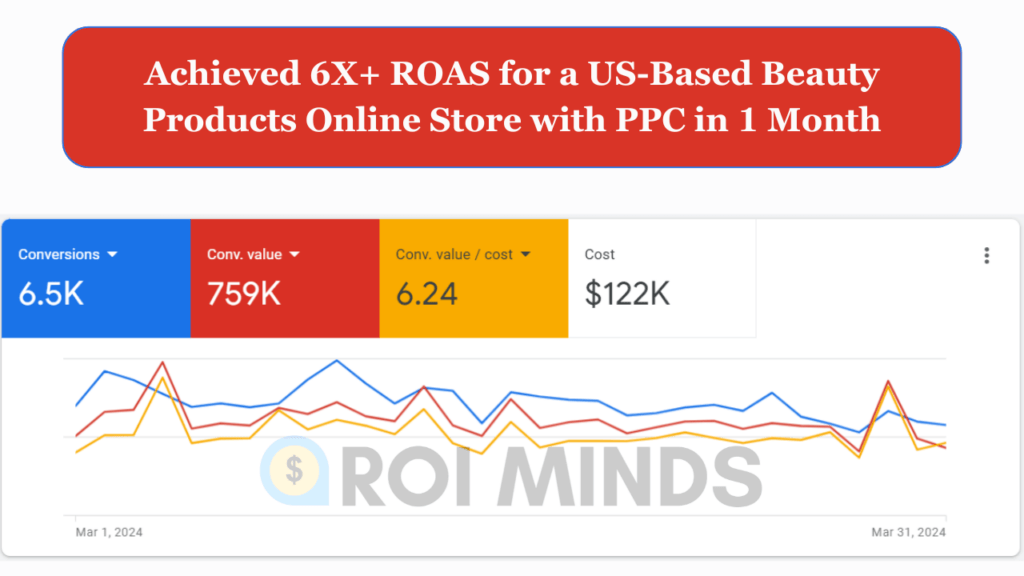
Conclusion
So, you have understood the strategies and tips for boosting ROAS. You can implement them in your adverts. Say your audience sees a stunning ad for a new mascara. They click, visit the website, and place an order within minutes. That’s how you use the power of effective PPC for cosmetic products!
Implementing these 5 Google Ads strategies can be beneficial for you. You can reach your target audience and achieve a 5X+ ROAS. Partnering with a professional beauty PPC advertising agency can enhance this.
Their expertise can help you refine and optimize your budget and campaigns. It ensures accurate results from your advertising efforts. Take action today. Unlock the true potential of Google Ads for beauty brands!
FAQ’S
Q1. How can PPC benefit beauty brands specifically?
PPC for cosmetic products allows you to target users searching for beauty solutions. Say someone is looking for “lengthening mascara.” Your ad can appear in their search results, driving qualified traffic to your website. PPC offers incredible control, letting you track every click and conversion.
Q2. Can you explain the concept of ROAS? Why is it significant in beauty PPC campaigns?
ROAS (Return On Ad Spend) is a critical metric in beauty PPC campaigns. It tells you how much revenue you generate for every dollar spent on ads. A 5X ROAS means earning $5 for every $1 invested. It’s important because it helps you measure the success of your campaigns.
Q3. Why is it crucial for beauty companies to invest in PPC advertising?
Consumers research and discover products online. PPC for beauty brands ensures you’re reaching your target audience. It puts your brand front and center, driving sales and brand awareness. Compared to traditional advertising, PPC offers superior targeting and measurability.
Q4. What budget range is recommended for beauty PPC advertising campaigns?
The budget depends on your brand size, goals, and competition. PPC advertising campaigns can cost anywhere from $100 to $2,000 monthly. For this, seek the help of an expert beauty PPC advertising agency.

